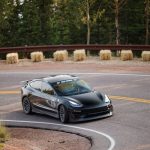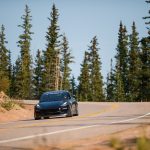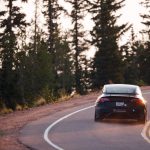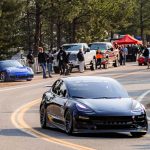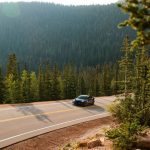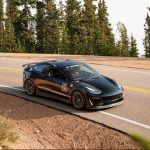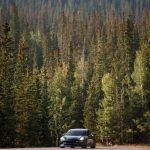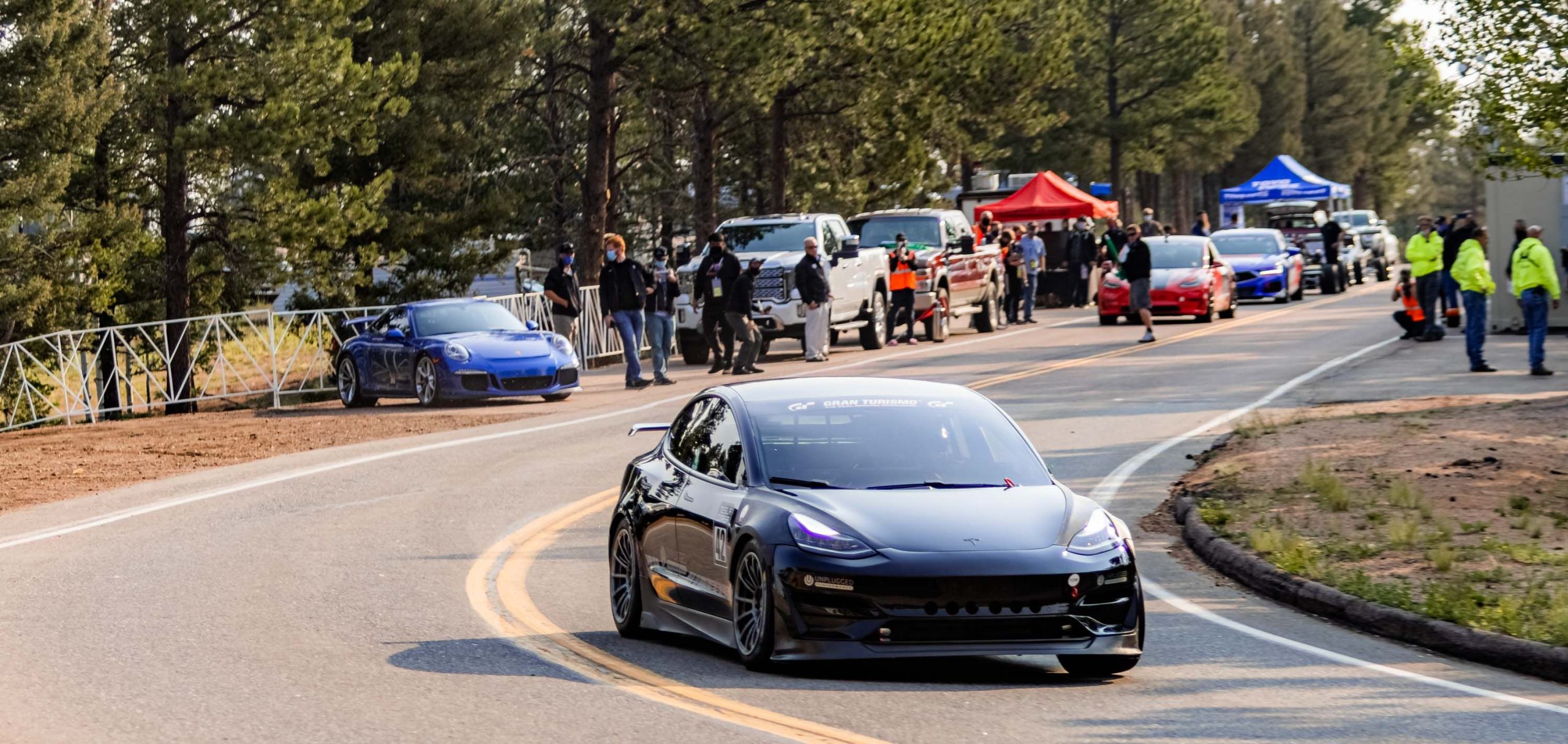
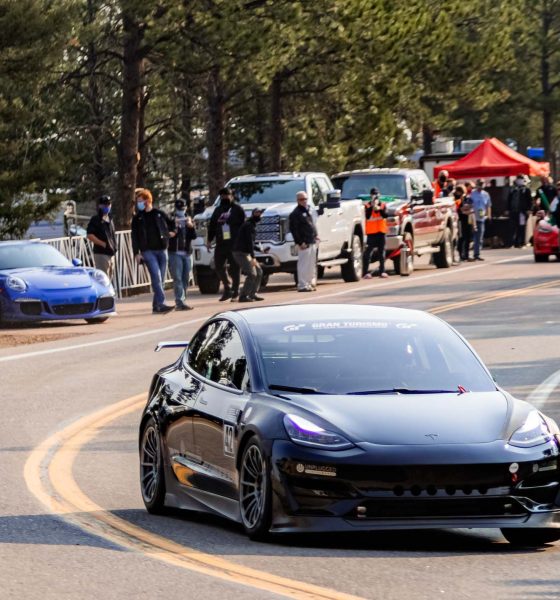
News
Tesla Model 3 dominates as qualifying leader in historic Pikes Peak run
The Unplugged Performance team and veteran racer Randy Pobst had planned to adopt a pretty conservative strategy for their modified Tesla Model 3 Performance’s first Pikes Peak run. The vehicle, after all, just had its suspension settings adjusted, and both team and driver wanted to validate how well the changes performed on the course. For the Model 3’s first run up Pikes Peak, the plan was to lift off on the straights to conserve battery for the second run, which would be flat out.
Needless to say, this plan did not end up being followed. At all.
Randy Pobst and Unplugged’s Model 3 Performance Ascension-R launched off into the Pikes Peak course for their first climb, and soon, it became evident to the racing veteran that the car was already almost perfectly dialed in. It was then that Pobst decided to forgo the initial plan and just attack the course at full power. With the veteran racer unleashed, the Model 3 completed the run in 4:15, finishing first place in the Exhibition class. Two other Teslas, a heavily modded widebody Model 3 driven by Joshua Allan and a Model 3 Performance driven by Blake Fuller, finished second and third
- Randy Pobst takes on Pikes Peak in the Tesla Model 3 Performance. (Credit: Unplugged Performance)
- Randy Pobst takes on Pikes Peak in the Tesla Model 3 Performance. (Credit: Unplugged Performance)
- Randy Pobst takes on Pikes Peak in the Tesla Model 3 Performance. (Credit: Unplugged Performance)
- Randy Pobst takes on Pikes Peak in the Tesla Model 3 Performance. (Credit: Unplugged Performance)
Randy Pobst takes on Pikes Peak in the Tesla Model 3 Performance. (Credit: Unplugged Performance)
As noted by Unplugged Performance CEO Ben Schaffer, he and his team were astounded to see Randy’s 4:15 time for his first run. The team had been targeting a time of 4:30 considering their planned strategy, but ultimately, what mattered was that the veteran racecar driver had tons of fun in his first climb of the day. Pobst did suggest some tweaks to the Model 3’s settings after, asking the Unplugged team to add a bit more compression and rebound tuning. But when those changes were done, the father of Track Mode was off for his second hill climb attempt.
Randy Pobst pushed the Model 3 Performance as hard as he could on his second run, and the results, as could be seen in the video below, were simply astounding. With the veteran racer behind the wheel and Unplugged’s parts performing as designed, the Model 3 Performance Ascension-R was able to complete the Pikes Peak run in a stunning 4:12. In second place was Blake Fuller’s Model 3 Performance, which completed the climb in 4:39. Unfortunately, the widebody Model 3 driven by Joshua Fuller retired after it went off track.
- Randy Pobst takes on Pikes Peak in the Tesla Model 3 Performance. (Credit: Unplugged Performance)
- Randy Pobst takes on Pikes Peak in the Tesla Model 3 Performance. (Credit: Unplugged Performance)
- Randy Pobst takes on Pikes Peak in the Tesla Model 3 Performance. (Credit: Unplugged Performance)
- Randy Pobst takes on Pikes Peak in the Tesla Model 3 Performance. (Credit: Unplugged Performance)
Randy Pobst takes on Pikes Peak in the Tesla Model 3 Performance. (Credit: Unplugged Performance)
What was particularly astounding about Randy Pobst’s 4:12 Pikes Peak Hill Climb run was the fact that the Model 3’s time was only a few seconds off from the record set by the fastest Open Wheel car in the event, which completed the climb in 4:07. The category in hosts some of the craziest purpose-built Pikes Peak machines in the industry, so it was quite surprising to see the Model 3, which only had Unplugged Performance’s Ascension-R modifications, performing in the level of Open Wheel vehicles. In fact, had the Model 3 been competing in the Open Wheel category, it would have finished the day in 3rd place. That’s a pretty insane thought.
“What surprised us the most today (besides capturing 1st place in qualifying) was how we compared to the other group running our section of the mountain. We ran with the Open Wheel cars and that group has some huge power and very lightweight cars. The fastest Open Wheel car was Clint Vahsholtz who ran a 4:07. If we were racing in the Open Wheel division, we would have qualified 3rd place which is pretty insane given how extreme those purpose-built cars are for this event,” Ben Schaffer said.
After dominating the Exhibition class in the event’s first day, Randy Pobst noted that the Tesla Model 3 is arguably the best car he has driven at Pikes Peak to date. This is no small statement, seeing as the legendary driver had climbed the challenging, dangerous course multiple times in the past behind the wheel of the industry’s most aggressive vehicles. “It was quite an honor to hear that from such a legendary driver that we respect so dearly,” the Unplugged CEO said.
Watch Randy Pobst’s stunning Pikes Peak run in the Tesla Model 3 in the video below.

News
Tesla Cybercab tests are going on overdrive with production-ready units
Tesla is ramping its real-world tests of the Cybercab, with multiple sightings of the vehicle being reported across social media this week.

Tesla is ramping its real-world tests of the Cybercab, with multiple sightings of the autonomous two-seater being reported across social media this week. Based on videos of the vehicle that have been shared online, it appears that Cybercab tests are underway across multiple states.
Recent Cybercab sightings
Reports of Cybercab tests have ramped this week, with a vehicle that looked like a production-ready prototype being spotted at Apple’s Visitor Center in California. The vehicle in this sighting was interesting as it was equipped with a steering wheel. The vehicle also featured some changes to the design of its brake lights.
The Cybercab was also filmed testing at the Fremont factory’s test track, which also seemed to involve a vehicle that looked production-ready. This also seemed to be the case for a Cybercab that was spotted in Austin, Texas, which happened to be undergoing real-world tests. Overall, these sightings suggest that Cybercab testing is fully underway, and the vehicle is really moving towards production.
Production design all but finalized?
Recently, a near-production-ready Cybercab was showcased at Tesla’s Santana Row showroom in San Jose. The vehicle was equipped with frameless windows, dual windshield wipers, powered butterfly door struts, an extended front splitter, an updated lightbar, new wheel covers, and a license plate bracket. Interior updates include redesigned dash/door panels, refined seats with center cupholders, updated carpet, and what appeared to be improved legroom.
There seems to be a pretty good chance that the Cybercab’s design has been all but finalized, at least considering Elon Musk’s comments at the 2025 Annual Shareholder Meeting. During the event, Musk confirmed that the vehicle will enter production around April 2026, and its production targets will be quite ambitious.
News
Tesla gets a win in Sweden as union withdraws potentially “illegal” blockade
As per recent reports, the Vision union’s planned anti-Tesla action might have been illegal.

Swedish union Vision has withdrawn its sympathy blockade against Tesla’s planned service center and showroom in Kalmar. As per recent reports, the Vision union’s planned anti-Tesla action might have been illegal.
Vision’s decision to pull the blockade
Vision announced the blockade in early December, stating that it was targeting the administrative handling of Tesla’s facility permits in Kalmar municipality. The sympathy measure was expected to start Monday, but was formally withdrawn via documents sent to the Mediation Institute and Kalmar Municipality last week.
As noted in a Daggers Arbete report, plans for the strike were ultimately pulled after employer group SKR highlighted potential illegality under the Public Employment Act. Vision stressed its continued backing for the Swedish labor model, though Deputy negotiation manager Oskar Pettersson explained that the Vision union and IF Metall made the decision to cancel the planned strike together.
“We will not continue to challenge the regulations,” Petterson said. “The objection was of a technical nature. We made the assessment together with IF Metall that we were not in a position to challenge the legal assessment of whether we could take this particular action against Tesla. Therefore, we chose to revoke the notice itself.”
The SKR’s warning
Petterson also stated that SKR’s technical objection to the Vision union’s planned anti-Tesla strike framed the protest as an unauthorized act. “It was a legal assessment of the situation. Both for us and for IF Metall, it is important to be clear that we stand for the Swedish model. But we should not continue to challenge the regulations and risk getting judgments that lead nowhere in the application of the regulations,” he said.
Vision ultimately canceled its planned blockade against Tesla on December 9. With Vision’s withdrawal, few obstacles remain for Tesla’s long-planned Kalmar site. A foreign electrical firm completed work this fall, and Tesla’s Careers page currently lists a full-time service manager position based there, signaling an imminent opening.
News
Tesla Semi program Director teases major improvements
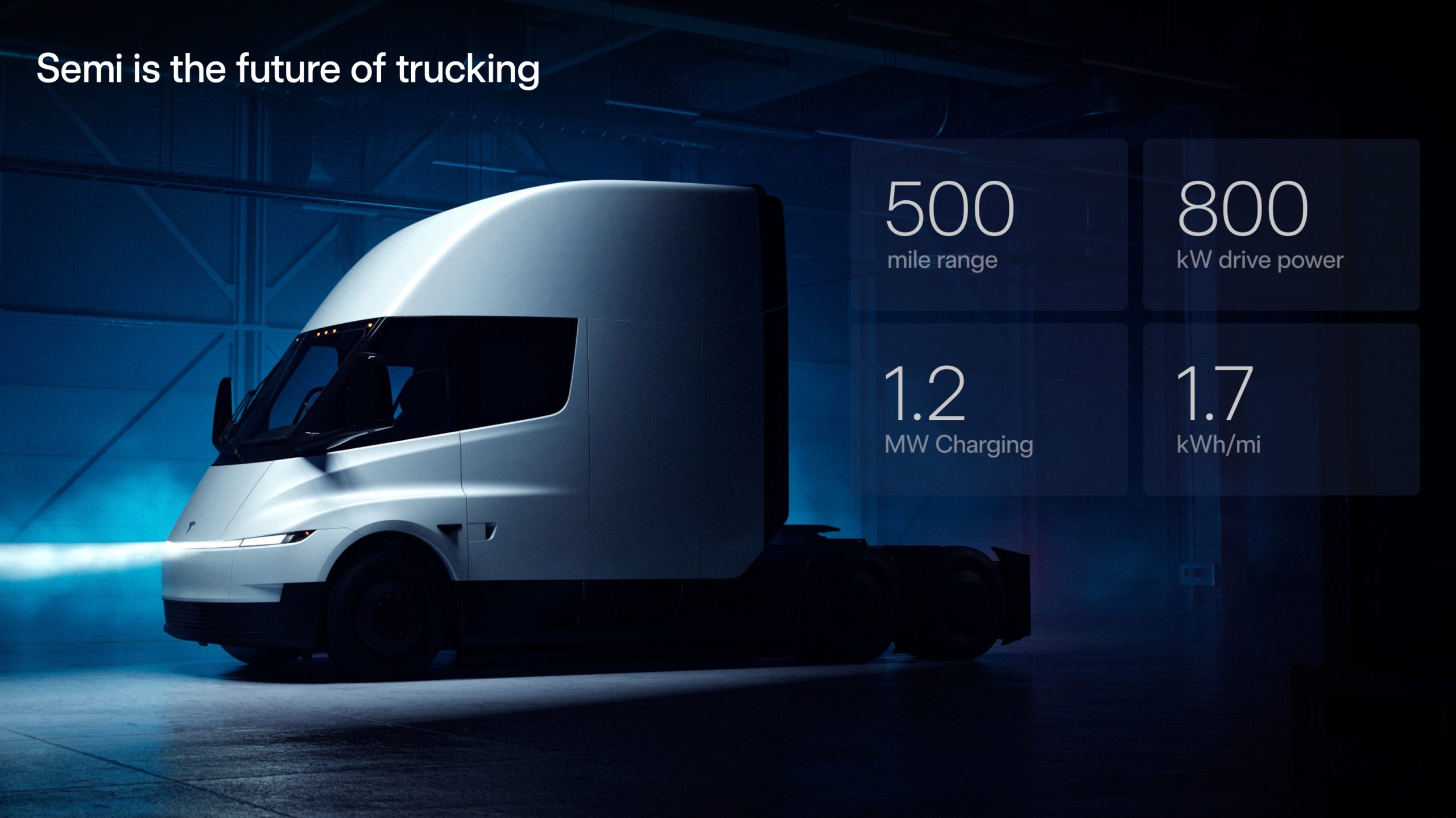
Tesla Semi Program Director Dan Priestly teased the major improvements to the all-electric Class 8 truck on Thursday night, following the company’s decision to overhaul the design earlier this year.
Priestley said he drove the Semi on Thursday, and the improvements appear to be welcomed by one of the minds behind the project. “Our customers are going to love it,” he concluded.
Just drove the redesigned Semi. Our customers are going to love it. https://t.co/KZ88sf1CDL
— Dan Priestley (@danWpriestley) December 19, 2025
The small detail does not seem like much, but it is coming from someone who has been involved in the development of the truck from A to Z. Priestley has been involved in the Semi program since November 2015 and has slowly worked his way through the ranks, and currently stands as the Director of the program.
Tesla Semi undergoes major redesign as dedicated factory preps for deliveries
Tesla made some major changes to the Semi design as it announced at the 2025 Annual Shareholder Meeting that it changed the look and design to welcome improvements in efficiency.
Initially, Tesla adopted the blade-like light bar for the Semi, similar to the one that is present on the Model Y Premium and the Cybertruck.
Additionally, there are some slight aesthetic changes to help with efficiency, including a redesigned bumper with improved aero channels, a smaller wraparound windshield, and a smoother roofline for better aero performance.
All of these changes came as the company’s Semi Factory, which is located on Gigafactory Nevada’s property, was finishing up construction in preparation for initial production phases, as Tesla is planning to ramp up manufacturing next year. CEO Elon Musk has said the Semi has attracted “ridiculous demand.”
The Semi has already gathered many large companies that have signed up to buy units, including Frito-Lay and PepsiCo., which have been helping Tesla test the vehicle in a pilot program to test range, efficiency, and other important metrics that will be a major selling point.
Tesla will be the Semi’s first user, though, and the truck will help solve some of the company’s logistics needs in the coming years.
